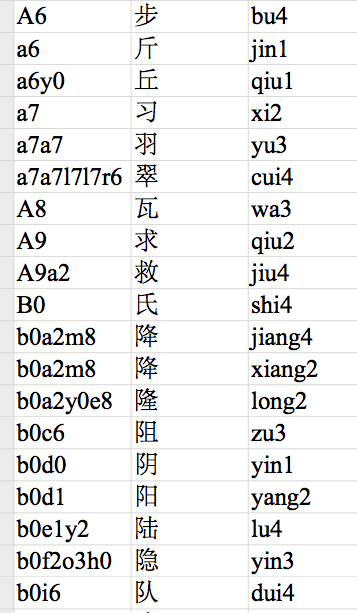The MandarWeb Website: The old Codel site page
Section 13. The old Codel site page
This website is an updated and greatly expanded version of The Codel System for Identifying Chinese Characters, which was released in 2008. If you need to look at the old version for any reason, it's at: http://www.aoi.com.au/mandarin/.
Why it's being brought up here, is that the ZCodelBase.pdf and ZMandarinBase.pdf files which you download to use MandarWeb are based on, but not now compatible with, their equivalents in the old version. Some features of the old version have carried through to the new one, though.
An example, here is an extract from the Codel file of the old version.

Notice that the Chinese characters shown vary in darkness and size a little bit. This is because the underlying database file in the old version used the very varied font images of characters as they were encountered.
In contrast, the characters in the new underlying database file have all been normalized to the same font (the Bento default font). An extract from the new Codel file shows this uniformity.

This doesn't affect your use of Mandarweb. However, it can explain what might seem like anomalies in the new Codel tables.
Here is another extract from the old Codel table.

Notice that two alternative forms are shown for the character "chuan1". These are exactly the same character, it's just that that they come from different fonts. But the fonts are different enough, that dissection of the character into its individual Codels may give a different result.
In the current version, the normal form for the character "chuan1", as depicted in the font currently used by your web browser, is 穿. The Codel tables used in MandarWeb use derivations of characters from a number of fonts. That is, in working out the Codels for "chuan1", you might arrive at "i8p7" or "r0h6p7". Looking either up in the Codel tables will still give you the same result, "chuan1".
In the same way, quite a number of alternative "decodings" of characters are included in the tables. The general rules are, left-to-right, top-to-bottom, and if parts to a character are physically joined, they are likely to be part of the same Codel.
But this is only an indication, whether parts of a character actually touch depends on how tightly it is packed. In the "chuan1" character shown above, notice that the left-hand version of the character has all parts run together, while in the right-hand version there are tiny separations between parts.
Also, some of the more complex Codels in the Codel grids could themselves be interpreted as the combination of several different smaller Codels. Where possible, all likely interpretations of a character are given in the Codel tables.
Return to the MandarWeb Home Page
(previous version 1.04, on Web 2008 Oct 22, see http://www.aoi.com.au/mandarin/ ).
Version 2.01, 2015 Mar 26.




